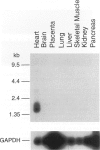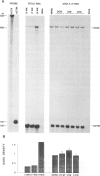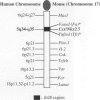Abstract
BACKGROUND: Csx/Nkx2.5, a murine nonclustered homeobox gene expressed primarily in the heart, has significant sequence similarity to the Drosophila tinman gene. Tinman is essential for heart and gut formation in Drosophila. Targeted mutation in the mouse gene, Csx/Nkx2.5, arrests cardiac development during early embryonic stages, suggesting an evolutionary conservation in cardiogenesis. MATERIALS AND METHODS: We have isolated and characterized a human homolog, hCsx, from an adult cardiac cDNA library. Northern blotting and ribonuclease protection was used to define the pattern of expression during normal development and in disease states. Chromosomal localization of the gene was determined by somatic cell hybrid analysis and fluorescent in situ hybridization. RESULTS: The predicted amino acid sequence of hCsx has 87% overall homology to the murine gene with 100% identity in the homeodomain. The homeodomain sequence of hCsx is 95% identical to its Xenopus homolog, and 65% to tinman. hCsx mRNA was detected exclusively in the heart. hCsx transcript was detected at 12 weeks in human embryonic heart, the earliest time point examined, and was up-regulated 5-fold between 12 and 19 weeks. There was no significant alteration of hCsx message level in the myocardium of 14 patients with end stage heart failure compared to a normal control. The human gene mapped to the distal portion of chromosome 5, the 5q34-q35 region. This defines a new synteny region between human chromosome 5q and the t-locus of mouse chromosome 17, where the mouse Csx gene is located. CONCLUSIONS: hCsx, the human homolog of Drosophila tinman, is expressed in heart in a tissue restricted manner. Distal 5q trisomies produce several phenotypic abnormalities, including a high incidence of congenital heart disease. Isolation of the hCsx gene will allow further studies of mutations in this gene and their potential associations with some forms of congenital heart disease in humans.
Full text
PDF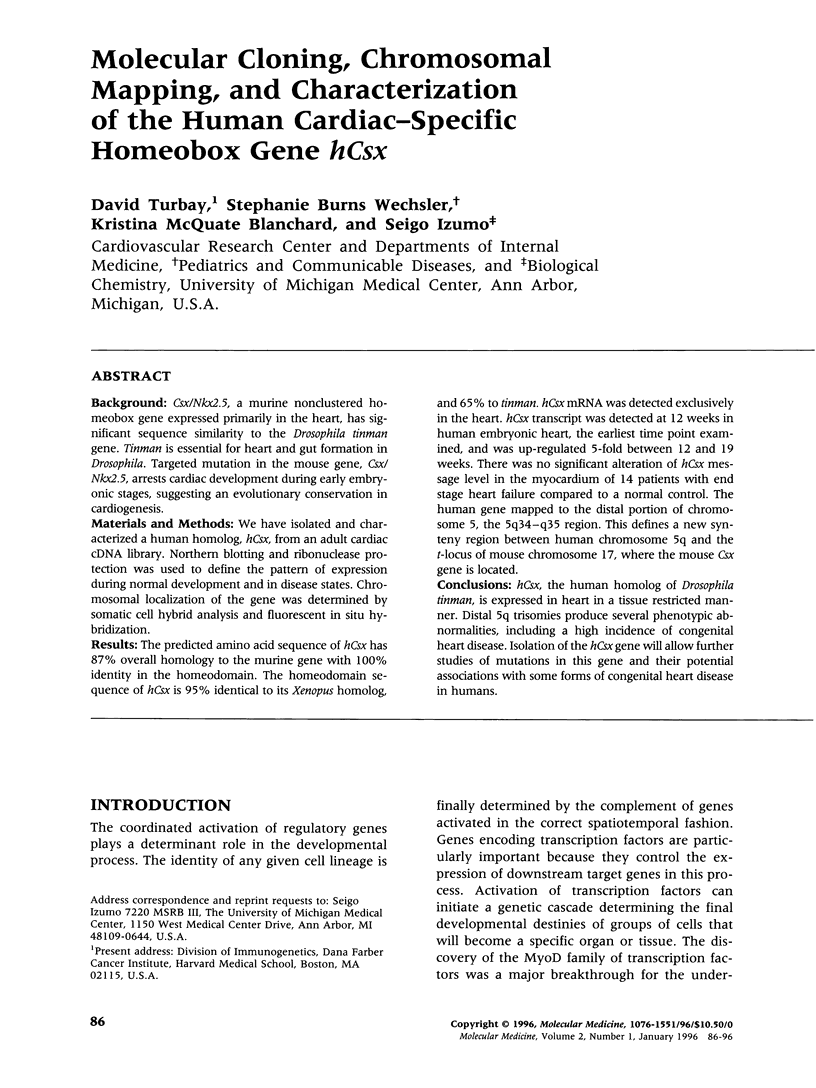
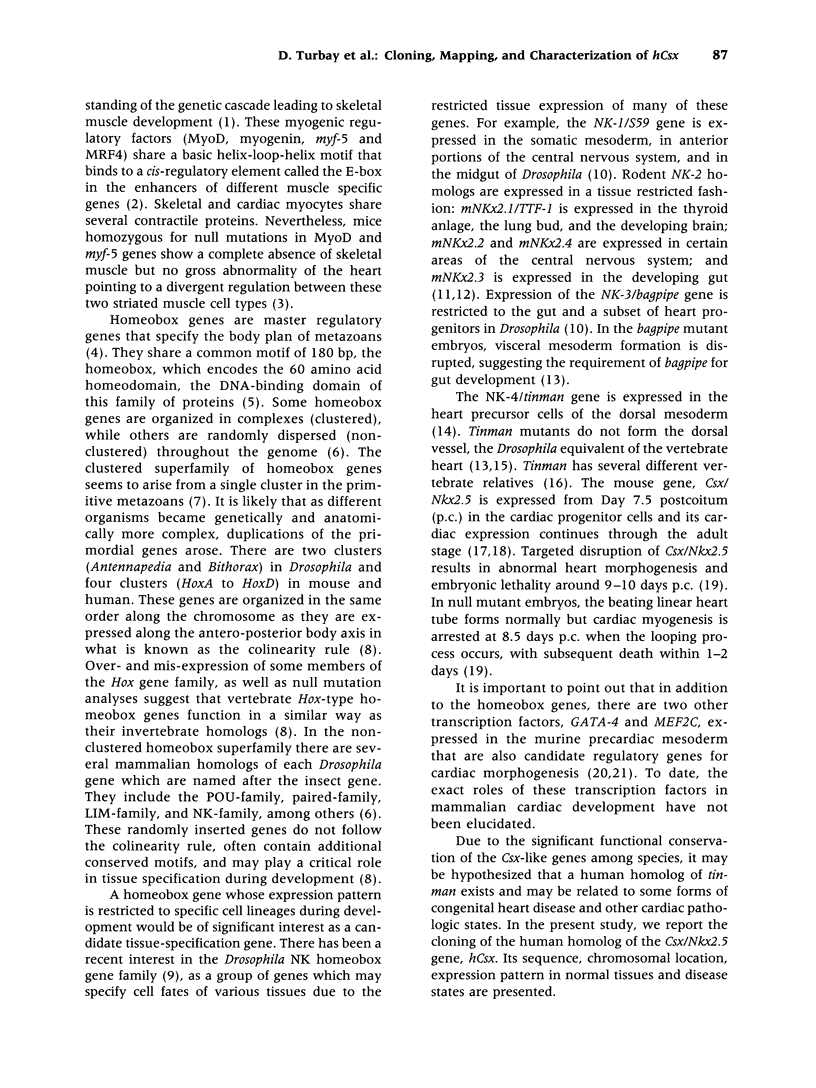
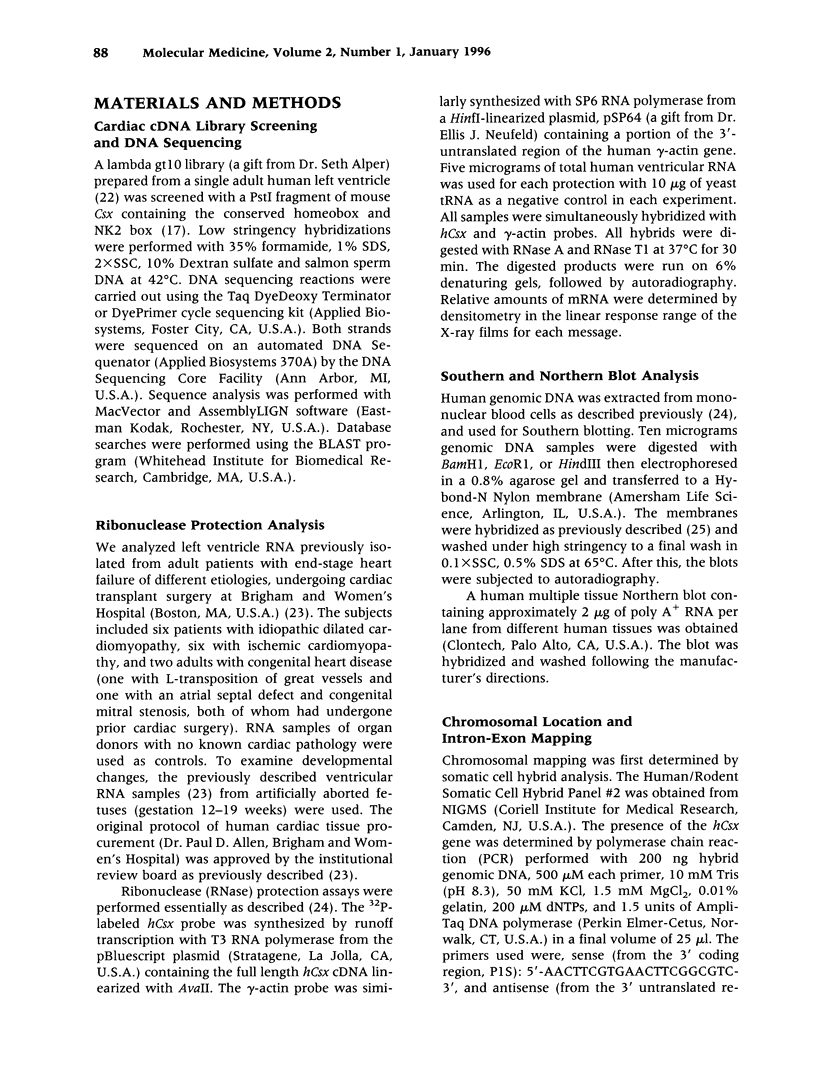
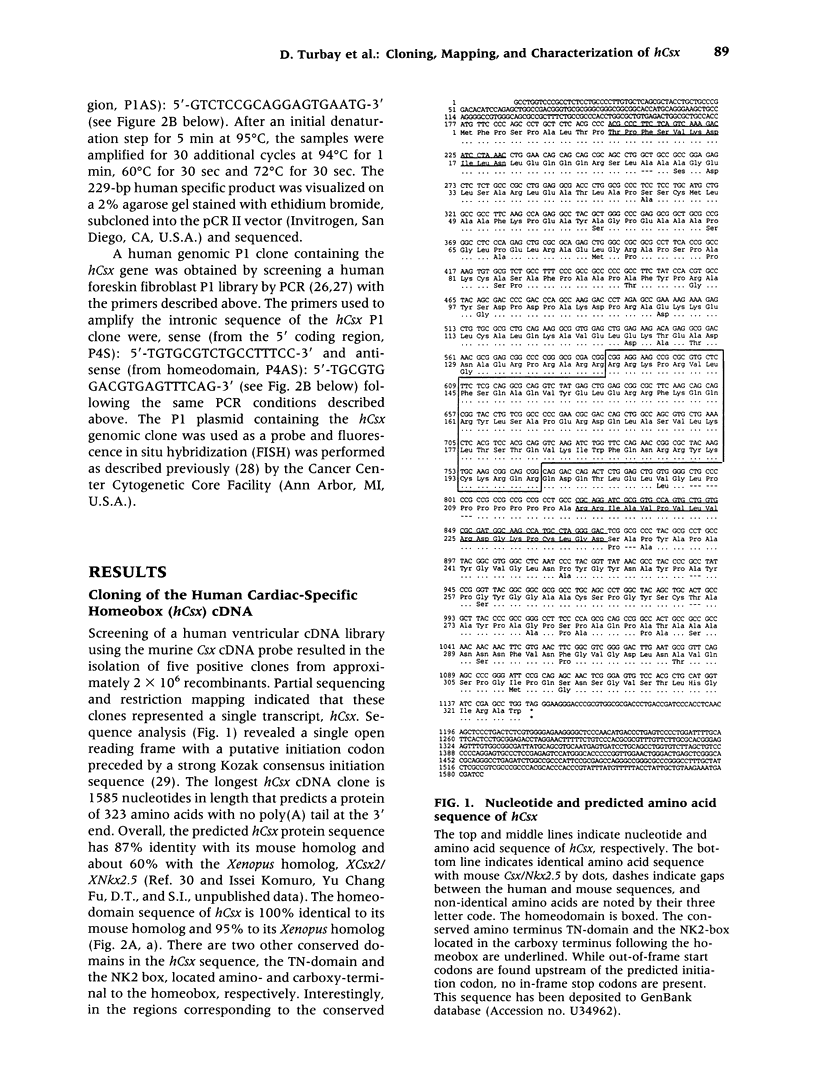
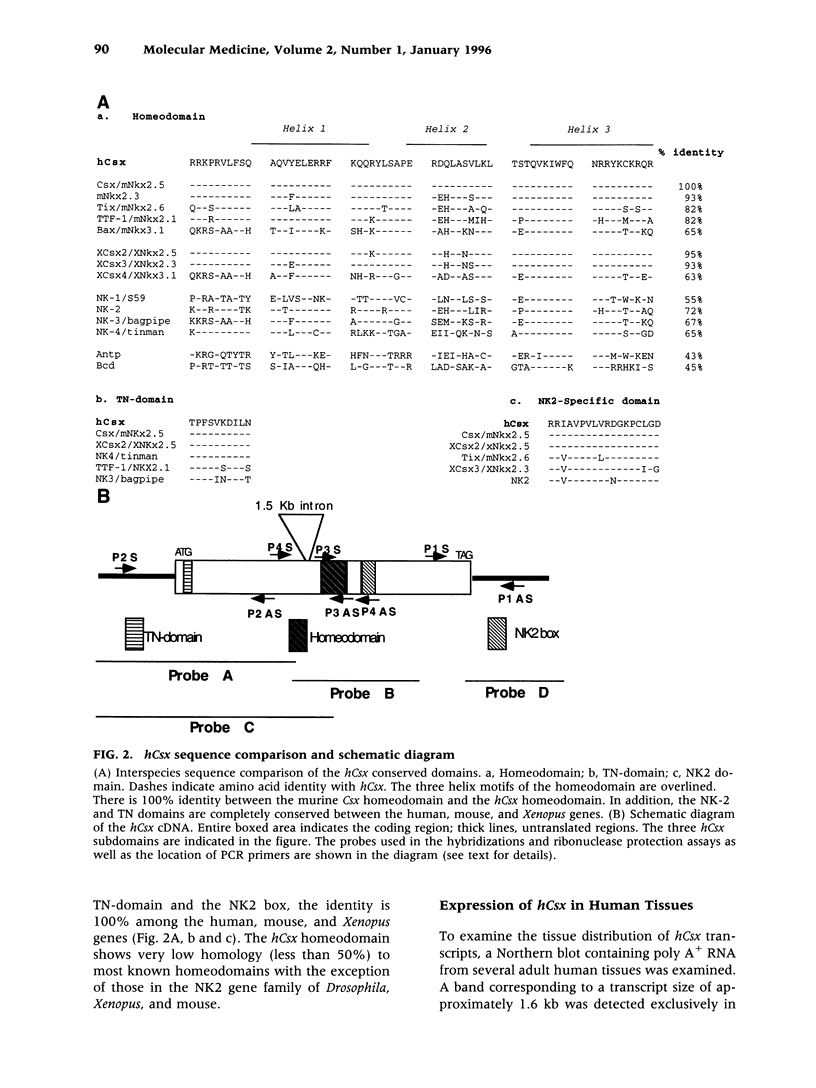

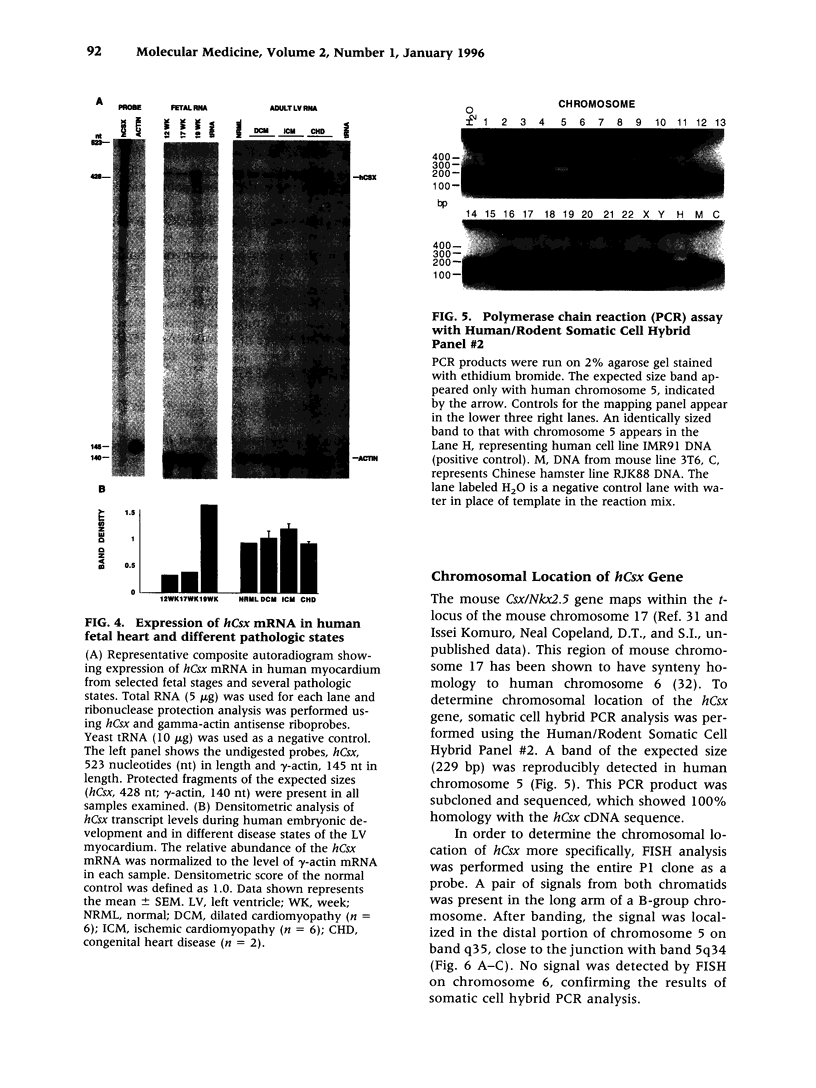
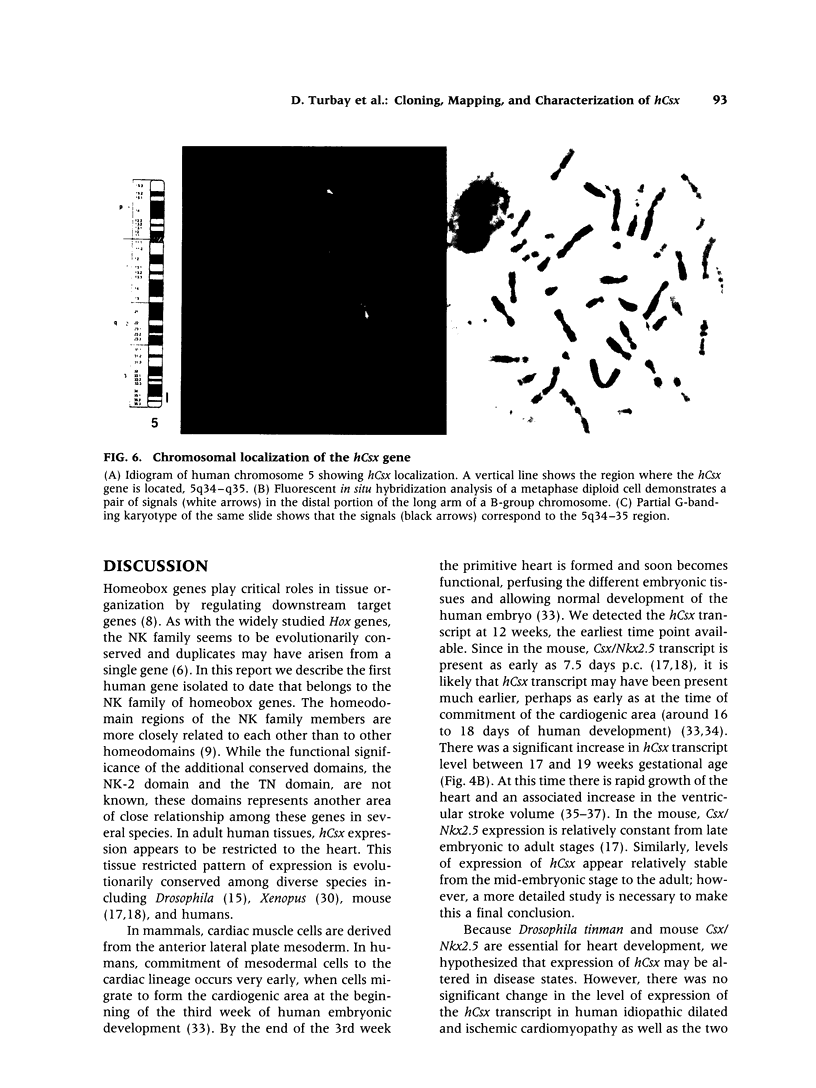
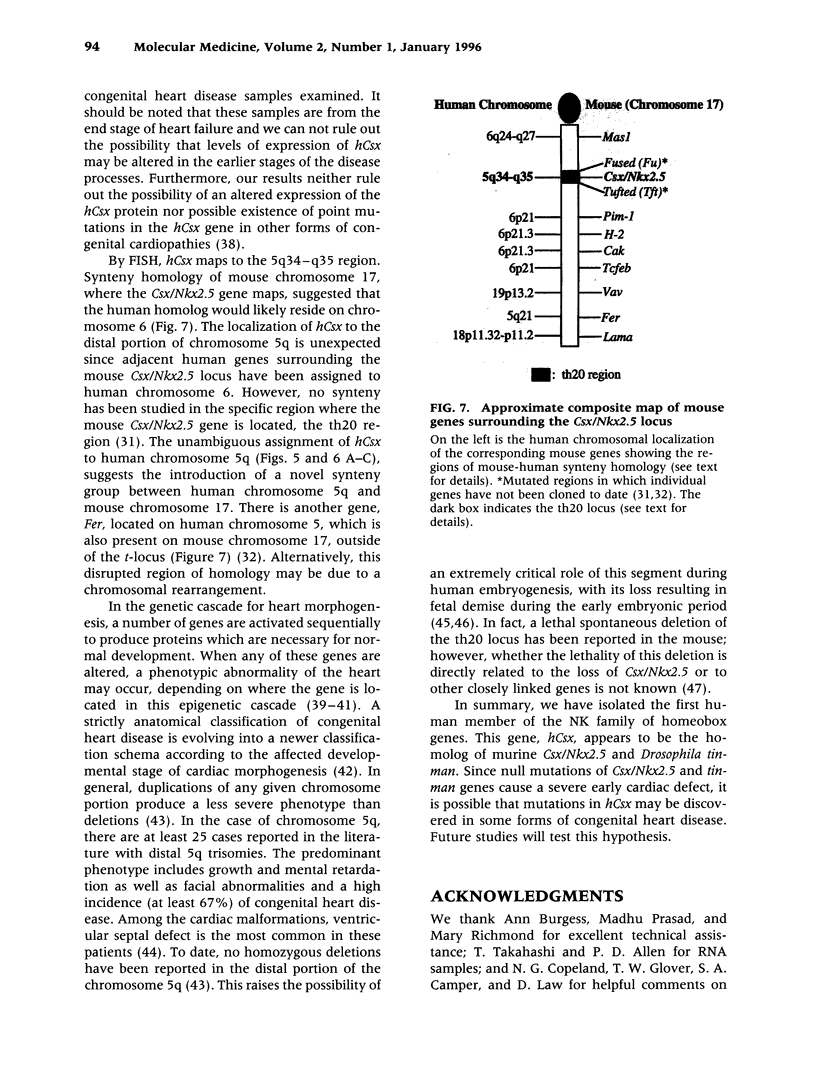
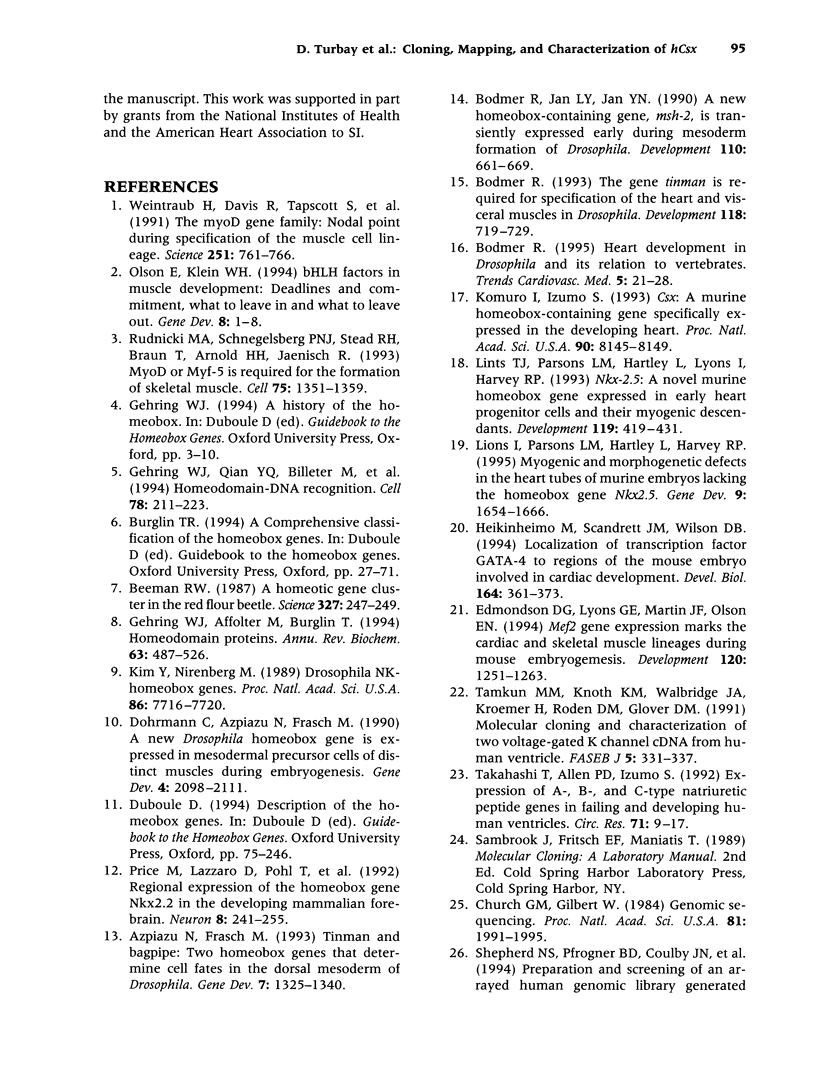
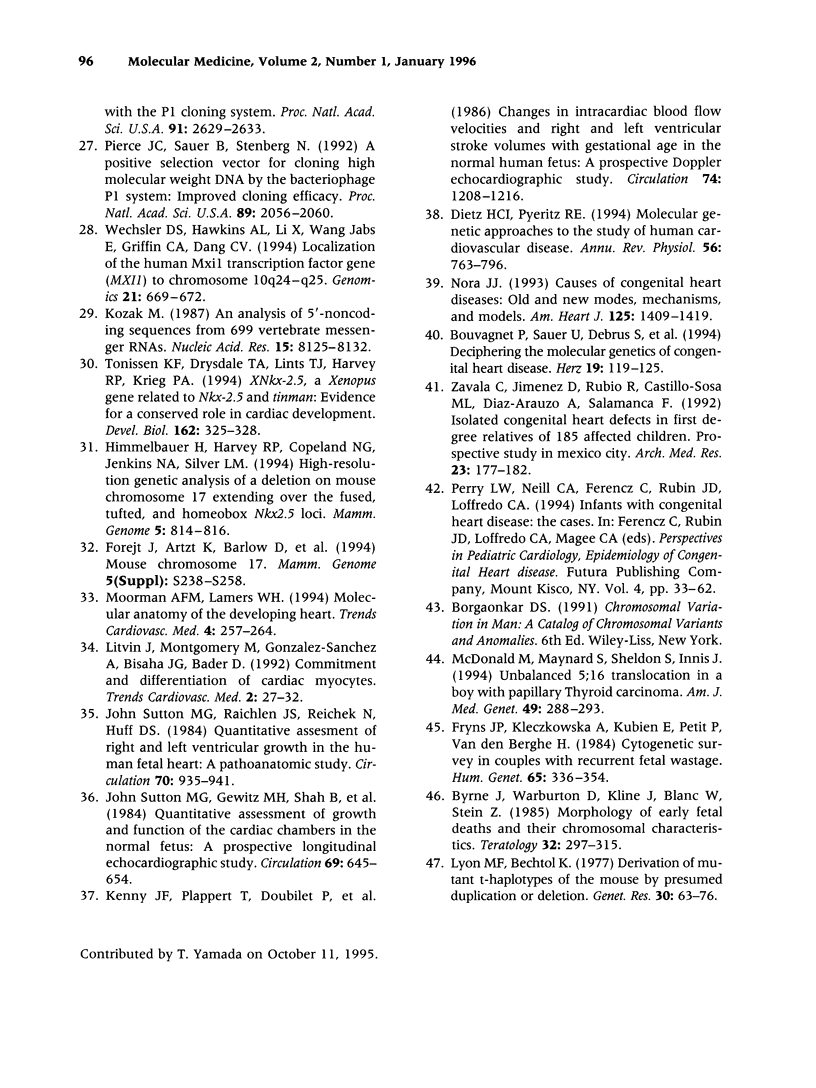
Images in this article
Selected References
These references are in PubMed. This may not be the complete list of references from this article.
- Azpiazu N., Frasch M. tinman and bagpipe: two homeo box genes that determine cell fates in the dorsal mesoderm of Drosophila. Genes Dev. 1993 Jul;7(7B):1325–1340. doi: 10.1101/gad.7.7b.1325. [DOI] [PubMed] [Google Scholar]
- Bodmer R., Jan L. Y., Jan Y. N. A new homeobox-containing gene, msh-2, is transiently expressed early during mesoderm formation of Drosophila. Development. 1990 Nov;110(3):661–669. doi: 10.1242/dev.110.3.661. [DOI] [PubMed] [Google Scholar]
- Bodmer R. The gene tinman is required for specification of the heart and visceral muscles in Drosophila. Development. 1993 Jul;118(3):719–729. doi: 10.1242/dev.118.3.719. [DOI] [PubMed] [Google Scholar]
- Bouvagnet P., Sauer U., Debrus S., Genz T., Alonso S., Berger G., De Meeus A., Bühlmeier K., Demaille J. Deciphering the molecular genetics of congenital heart disease. Herz. 1994 Apr;19(2):119–125. [PubMed] [Google Scholar]
- Byrne J., Warburton D., Kline J., Blanc W., Stein Z. Morphology of early fetal deaths and their chromosomal characteristics. Teratology. 1985 Oct;32(2):297–315. doi: 10.1002/tera.1420320218. [DOI] [PubMed] [Google Scholar]
- Church G. M., Gilbert W. Genomic sequencing. Proc Natl Acad Sci U S A. 1984 Apr;81(7):1991–1995. doi: 10.1073/pnas.81.7.1991. [DOI] [PMC free article] [PubMed] [Google Scholar]
- Dietz H. C., 3rd, Pyeritz R. E. Molecular genetic approaches to the study of human cardiovascular disease. Annu Rev Physiol. 1994;56:763–796. doi: 10.1146/annurev.ph.56.030194.003555. [DOI] [PubMed] [Google Scholar]
- Dohrmann C., Azpiazu N., Frasch M. A new Drosophila homeo box gene is expressed in mesodermal precursor cells of distinct muscles during embryogenesis. Genes Dev. 1990 Dec;4(12A):2098–2111. doi: 10.1101/gad.4.12a.2098. [DOI] [PubMed] [Google Scholar]
- Edmondson D. G., Lyons G. E., Martin J. F., Olson E. N. Mef2 gene expression marks the cardiac and skeletal muscle lineages during mouse embryogenesis. Development. 1994 May;120(5):1251–1263. doi: 10.1242/dev.120.5.1251. [DOI] [PubMed] [Google Scholar]
- Forejt J., Artzt K., Barlow D. P., Hamvas R. M., Lindahl K. F., Lyon M. F., Klein J., Silver L. M. Mouse chromosome 17. Mamm Genome. 1994;5(Spec No):S238–S258. [PubMed] [Google Scholar]
- Fryns J. P., Kleczkowska A., Kubień E., Petit P., Van den Berghe H. Cytogenetic survey in couples with recurrent fetal wastage. Hum Genet. 1984;65(4):336–354. doi: 10.1007/BF00291558. [DOI] [PubMed] [Google Scholar]
- Gehring W. J., Affolter M., Bürglin T. Homeodomain proteins. Annu Rev Biochem. 1994;63:487–526. doi: 10.1146/annurev.bi.63.070194.002415. [DOI] [PubMed] [Google Scholar]
- Gehring W. J., Qian Y. Q., Billeter M., Furukubo-Tokunaga K., Schier A. F., Resendez-Perez D., Affolter M., Otting G., Wüthrich K. Homeodomain-DNA recognition. Cell. 1994 Jul 29;78(2):211–223. doi: 10.1016/0092-8674(94)90292-5. [DOI] [PubMed] [Google Scholar]
- Heikinheimo M., Scandrett J. M., Wilson D. B. Localization of transcription factor GATA-4 to regions of the mouse embryo involved in cardiac development. Dev Biol. 1994 Aug;164(2):361–373. doi: 10.1006/dbio.1994.1206. [DOI] [PubMed] [Google Scholar]
- Himmelbauer H., Harvey R. P., Copeland N. G., Jenkins N. A., Silver L. M. High-resolution genetic analysis of a deletion on mouse chromosome 17 extending over the fused, tufted, and homeobox Nkx2-5 loci. Mamm Genome. 1994 Dec;5(12):814–816. doi: 10.1007/BF00292022. [DOI] [PubMed] [Google Scholar]
- Kenny J. F., Plappert T., Doubilet P., Saltzman D. H., Cartier M., Zollars L., Leatherman G. F., St John Sutton M. G. Changes in intracardiac blood flow velocities and right and left ventricular stroke volumes with gestational age in the normal human fetus: a prospective Doppler echocardiographic study. Circulation. 1986 Dec;74(6):1208–1216. doi: 10.1161/01.cir.74.6.1208. [DOI] [PubMed] [Google Scholar]
- Kim Y., Nirenberg M. Drosophila NK-homeobox genes. Proc Natl Acad Sci U S A. 1989 Oct;86(20):7716–7720. doi: 10.1073/pnas.86.20.7716. [DOI] [PMC free article] [PubMed] [Google Scholar]
- Komuro I., Izumo S. Csx: a murine homeobox-containing gene specifically expressed in the developing heart. Proc Natl Acad Sci U S A. 1993 Sep 1;90(17):8145–8149. doi: 10.1073/pnas.90.17.8145. [DOI] [PMC free article] [PubMed] [Google Scholar]
- Kozak M. An analysis of 5'-noncoding sequences from 699 vertebrate messenger RNAs. Nucleic Acids Res. 1987 Oct 26;15(20):8125–8148. doi: 10.1093/nar/15.20.8125. [DOI] [PMC free article] [PubMed] [Google Scholar]
- Lints T. J., Parsons L. M., Hartley L., Lyons I., Harvey R. P. Nkx-2.5: a novel murine homeobox gene expressed in early heart progenitor cells and their myogenic descendants. Development. 1993 Oct;119(2):419–431. doi: 10.1242/dev.119.2.419. [DOI] [PubMed] [Google Scholar]
- Lyon M. F., Bechtol K. B. Derivation of mutant t-haplotypes of the mouse by presumed duplication or deletion. Genet Res. 1977 Aug;30(1):63–76. doi: 10.1017/s0016672300017468. [DOI] [PubMed] [Google Scholar]
- Lyons I., Parsons L. M., Hartley L., Li R., Andrews J. E., Robb L., Harvey R. P. Myogenic and morphogenetic defects in the heart tubes of murine embryos lacking the homeo box gene Nkx2-5. Genes Dev. 1995 Jul 1;9(13):1654–1666. doi: 10.1101/gad.9.13.1654. [DOI] [PubMed] [Google Scholar]
- McDonald M., Maynard S., Sheldon S., Innis J. Unbalanced 5;16 translocation in a boy with papillary thyroid carcinoma. Am J Med Genet. 1994 Feb 1;49(3):288–293. doi: 10.1002/ajmg.1320490309. [DOI] [PubMed] [Google Scholar]
- Nora J. J. Causes of congenital heart diseases: old and new modes, mechanisms, and models. Am Heart J. 1993 May;125(5 Pt 1):1409–1419. doi: 10.1016/0002-8703(93)91014-6. [DOI] [PubMed] [Google Scholar]
- Pierce J. C., Sauer B., Sternberg N. A positive selection vector for cloning high molecular weight DNA by the bacteriophage P1 system: improved cloning efficacy. Proc Natl Acad Sci U S A. 1992 Mar 15;89(6):2056–2060. doi: 10.1073/pnas.89.6.2056. [DOI] [PMC free article] [PubMed] [Google Scholar]
- Price M., Lazzaro D., Pohl T., Mattei M. G., Rüther U., Olivo J. C., Duboule D., Di Lauro R. Regional expression of the homeobox gene Nkx-2.2 in the developing mammalian forebrain. Neuron. 1992 Feb;8(2):241–255. doi: 10.1016/0896-6273(92)90291-k. [DOI] [PubMed] [Google Scholar]
- Rudnicki M. A., Schnegelsberg P. N., Stead R. H., Braun T., Arnold H. H., Jaenisch R. MyoD or Myf-5 is required for the formation of skeletal muscle. Cell. 1993 Dec 31;75(7):1351–1359. doi: 10.1016/0092-8674(93)90621-v. [DOI] [PubMed] [Google Scholar]
- St John Sutton M. G., Gewitz M. H., Shah B., Cohen A., Reichek N., Gabbe S., Huff D. S. Quantitative assessment of growth and function of the cardiac chambers in the normal human fetus: a prospective longitudinal echocardiographic study. Circulation. 1984 Apr;69(4):645–654. doi: 10.1161/01.cir.69.4.645. [DOI] [PubMed] [Google Scholar]
- St John Sutton M. G., Raichlen J. S., Reichek N., Huff D. S. Quantitative assessment of right and left ventricular growth in the human fetal heart: a pathoanatomic study. Circulation. 1984 Dec;70(6):935–941. doi: 10.1161/01.cir.70.6.935. [DOI] [PubMed] [Google Scholar]
- Tamkun M. M., Knoth K. M., Walbridge J. A., Kroemer H., Roden D. M., Glover D. M. Molecular cloning and characterization of two voltage-gated K+ channel cDNAs from human ventricle. FASEB J. 1991 Mar 1;5(3):331–337. doi: 10.1096/fasebj.5.3.2001794. [DOI] [PubMed] [Google Scholar]
- Tonissen K. F., Drysdale T. A., Lints T. J., Harvey R. P., Krieg P. A. XNkx-2.5, a Xenopus gene related to Nkx-2.5 and tinman: evidence for a conserved role in cardiac development. Dev Biol. 1994 Mar;162(1):325–328. doi: 10.1006/dbio.1994.1089. [DOI] [PubMed] [Google Scholar]
- Wechsler D. S., Hawkins A. L., Li X., Jabs E. W., Griffin C. A., Dang C. V. Localization of the human Mxi1 transcription factor gene (MXI1) to chromosome 10q24-q25. Genomics. 1994 Jun;21(3):669–672. doi: 10.1006/geno.1994.1336. [DOI] [PubMed] [Google Scholar]
- Weintraub H., Davis R., Tapscott S., Thayer M., Krause M., Benezra R., Blackwell T. K., Turner D., Rupp R., Hollenberg S. The myoD gene family: nodal point during specification of the muscle cell lineage. Science. 1991 Feb 15;251(4995):761–766. doi: 10.1126/science.1846704. [DOI] [PubMed] [Google Scholar]
- Zavala C., Jiménez D., Rubio R., Castillo-Sosa M. L., Díaz-Arauzo A., Salamanca F. Isolated congenital heart defects in first degree relatives of 185 affected children. Prospective study in Mexico City. Arch Med Res. 1992 Winter;23(4):177–182. [PubMed] [Google Scholar]



